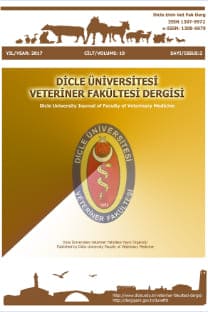Streptozotosin ile Diyabet Oluşturulan Sıçanlarda Meşe Palamudu (Quercus branti Lindl.) Ekstraktların Karaciğer ve Pankreası Koruyucu Etkileri
Diabetes mellitus (DM) tüm dünyada en sık rastlanan kronik endokrin bozukluktur. Sunulan bu çalışmada, streptozotosin (STZ) ile oluşturulan diyabetik sıçan modelinde, karaciğer ve pankreas yapısında ortaya çıkan histolojik değişiklikler üzerine güçlü antioksidan özelliklere sahip olan meşe palamudu (Quercus branti Lindl.) ekstraktının farklı dozlarının koruyucu etkinliği diyabet tedavisinde kullanılan ticari bir preparasyon olan Akarboz (Glukobay®) ile kıyaslamalı olarak araştırıldı. Kırkiki adet erkek Wistar albino cinsi sıçan; Kontrol; Diabetes mellitus (DM); DM + 20 mg/kg Akarboz; DM + 100 mg/kg meşe palamudu (MP) ekstresi (MP1); DM + 250 mg/kg MP ekstresi (MP2) grubu, DM + 500 mg/kg MP ekstresi (MP3) olmak üzere 6 gruba ayrıldı. Deneysel diyabet 50 mg/kg streptozotosinin intraperitoneal (i.p.) olarak enjeksiyonu ile oluşturuldu. Meşe palamudu ekstraktının tüm dozları ve Akarboz 21 gün boyunca gastrik gavaj yolu ile verildi. Kan glukoz düzeyleri deney süresince kaydedildi. Karaciğer kesitlerinin incelenmesinde, diyabetik sıçanlarda hepatositlerde dejenerasyon ve nekroz, portal alanlarda yangısal hücre infiltrasyonu, fibrozis ve safra kanalı hiperplazisi görüldü. Pankreas kesitlerinde langerhans adacıklarının belirgin hücre kaybı sonucu normal görünümünü kaybettiği gözlendi. Bu histopatolojik değişiklikler meşe palamudu ekstraktı verilen MP1, MP2 ve MP3 gruplarında önemli derecede azalmıştı. Sonuç olarak, meşe palamudu ekstraktının sıçanlarda STZ ile oluşturulan diyabette karaciğer ve pankreas hasarına karşı koruyucu etkiye sahip olduğu sunulan bu çalışma ile ortaya konmuştur.
Protective Effects of Acorn (Quercus Branti lindl.) Extract on Liver and Pancreas in Streptozotocin-İnduced Diabetic Rats
Diabetes mellitus (DM) is the most common chronic endocrine disorder in worldwide. The protective effects of acorn (Quercus branti Lindl.) extract, potent antioxidant properties, were investigated on histological changes of liver and pancreas in streptozotocin (STZ)-induced diabetic rats in this study. For this purpose the effect of different doses of extract were compared with Akarboz (Glukobay®), a commercial anti-diabetic preparation. Forty-two healthy Wistar albino male rats were divided into six groups as Control; Diabetes mellitus (DM); DM+Akarboz 20 mg/kg; DM+100 mg/kg acorn (MP1); DM+250 mg/kg acorn extract (MP2); DM+500 mg/kg acorn (MP3). Experimental diabetes was induced by a single-dose [50 mg/kg, intra-peritoneal (i.p)] STZ injection. Essential dosages of acorn extracts and Akarboz were applied with gastric gavage for 21 day. Blood glucose levels were recorded throughout the all experiment period. Examination of stained liver sections revealed necrosis and degeneration of hepatocytes, inflammatory cell infiltration and fibrosis in portal area and bile duct hyperplasia in the diabetic rats. Marked abnormal histology with evident cell loss were detected in pancreas tissues. These histopathological changes were significantly decreased in MP1, MP2 and MP3 groups with administration of acorn extract. In conclusion the present study indicates that acorn extract have a protective effect on hepatic and pancreatic damage in STZ-induced diabetic rats.
